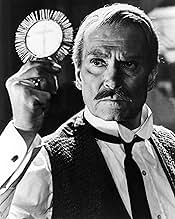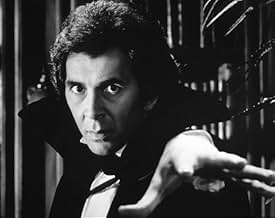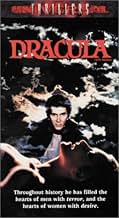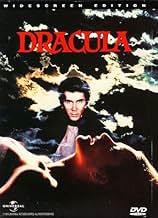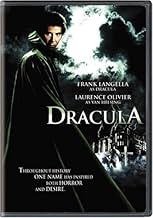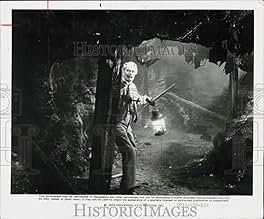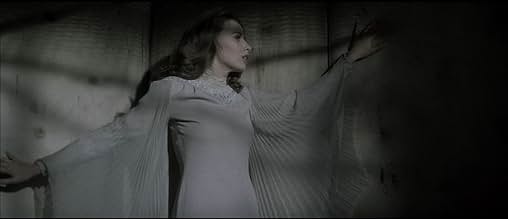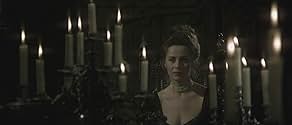NOTE IMDb
6,5/10
12 k
MA NOTE
En 1913, le comte Dracula, un vampire charmant, séduisant et sinistre, se rend en Angleterre à la recherche d'une épouse immortelle.En 1913, le comte Dracula, un vampire charmant, séduisant et sinistre, se rend en Angleterre à la recherche d'une épouse immortelle.En 1913, le comte Dracula, un vampire charmant, séduisant et sinistre, se rend en Angleterre à la recherche d'une épouse immortelle.
- Réalisation
- Scénario
- Casting principal
- Récompenses
- 3 victoires et 4 nominations au total
Sylvester McCoy
- Walter
- (as Sylveste McCoy)
Dan Meaden
- Asylum Nurse
- (non crédité)
Avis à la une
It is surprising to me that, given the popular and critical praise so many mediocre vampire movies have received( this includes the badly dated Hammer flicks), this movie is often dismissed as minor and forgettable. While it is true that the definitive version is still Coppola's 1992 film, this overlooked gem deserves much more attention and praise than it currently gets.
It was possibly the first vampire movie to play up the romantic and sexual implications of the vampire legend, while at the same time remaining faithful to the underlying idea of Stoker's novel( that is, a fight between good and evil). It is worth pointing out that the film depicts count Dracula as a good looking, seductive and charming aristocrat, rather than an impulsive blood-thirsty creature. He is a broody, lonely character, seeking for a female partner with whom share his everlasting loneliness, something he seems to find in the form of Lucy Seward, an independent and strong-willed Victorian lady.
But the fact that this Dracula has a romantic strain to him does not conceal his ultimately evil nature. He consciously seduces and attacks ill, defenseless Mina just for the excitement of it. When Dr Van Helsing meets her at the graveyard galleries, she is no longer that frail but charming girl, but a deathly-pale,putrid, disgusting figure. That is what Dracula's hobby implies.
Badham does an excellent job. He effectively uses Gothic imagery and low key lightning to create an eerie and slightly surreal atmosphere.But what really stands out in this version is the cast. Everyone fits their role perfectly.Langella plays a seductive count. Olivier,inspired by Cushing's performance in 1958 Dracula, puts in a riveting performance as a frail, tortured Van Helsing, with an emotional stake in the story (pun intended). Kate Nelligan( a fine Canadian supporting actress,also starring in Eye of the Needle) delivers a fresh performance. Even Harker's character , which is usually the main casting weakness when it comes to Dracula movies, is quite well handled here, played by an actor with the right appearance.
There are minor flaws, the most important of them being a lack of screen time devoted to the romance and a muddled color scheme, but this film is nevertheless worth a look, an engaging retelling of the classic horror tale with a poetic, broody edge to it.
It was possibly the first vampire movie to play up the romantic and sexual implications of the vampire legend, while at the same time remaining faithful to the underlying idea of Stoker's novel( that is, a fight between good and evil). It is worth pointing out that the film depicts count Dracula as a good looking, seductive and charming aristocrat, rather than an impulsive blood-thirsty creature. He is a broody, lonely character, seeking for a female partner with whom share his everlasting loneliness, something he seems to find in the form of Lucy Seward, an independent and strong-willed Victorian lady.
But the fact that this Dracula has a romantic strain to him does not conceal his ultimately evil nature. He consciously seduces and attacks ill, defenseless Mina just for the excitement of it. When Dr Van Helsing meets her at the graveyard galleries, she is no longer that frail but charming girl, but a deathly-pale,putrid, disgusting figure. That is what Dracula's hobby implies.
Badham does an excellent job. He effectively uses Gothic imagery and low key lightning to create an eerie and slightly surreal atmosphere.But what really stands out in this version is the cast. Everyone fits their role perfectly.Langella plays a seductive count. Olivier,inspired by Cushing's performance in 1958 Dracula, puts in a riveting performance as a frail, tortured Van Helsing, with an emotional stake in the story (pun intended). Kate Nelligan( a fine Canadian supporting actress,also starring in Eye of the Needle) delivers a fresh performance. Even Harker's character , which is usually the main casting weakness when it comes to Dracula movies, is quite well handled here, played by an actor with the right appearance.
There are minor flaws, the most important of them being a lack of screen time devoted to the romance and a muddled color scheme, but this film is nevertheless worth a look, an engaging retelling of the classic horror tale with a poetic, broody edge to it.
Director John Badam's 1979 reboot of Dracula is a very well crafted and interesting film. While Frank Langella's performance may have been a bit too romantic, or the film may not be bloody enough for some horror purists, Dracula 1979 is a long ways away from something like Twilight and has a lot for horror fans to appreciate and enjoy here. This is a serious minded, big budgeted and intelligent take on the Dracula story. It is a very well shot, great looking film with very good f/x, direction and a haunting score by John Williams of Star Wars fame. Dracula is portrayed here as a seductive, romantic and tragic figure. While some may have felt Dracula was a bit too much of a ladies man, Frank Langella made it work with his exceptional performance and is a very talented actor. Also immensely talented actors Lawrence Oliver and Donald Pleasance shine here as well as Van Helsing and Dr. Jack Seward. The rest of the cast was also very good and as a whole, I enjoy this picture and is a very well done and classy Gothic horror film.
In Whitby, England, the sick Mina Van Helsing (Jan Francis) is spending some days with her friend Lucy Seward (Kate Nelligan) and her father Dr. Jack Seward (Donald Pleasence) in their house that is also an asylum at the seaside. When a ship wrecks on the coast, all the crew is dead and Mina helps the only survivor Count Dracula (Frank Langella), who has just bought the Fairfax Abbey through Lucy's fiancé Jonathan Harker (Trevor Eve). Soon Dracula drinks Mina's blood killing her. Dr. Seward summons Mina's father Prof. Abraham Van Helsing (Laurence Olivier) for the funeral but he arrives late. On the next night, the son of the patient Annie (Janine Duvitski) is attacked by Mina. Prof. Van Helsing discovers that his daughter is undead and the Count Dracula is a vampire. Now Van Helsing, Dr. Seward and Jonathan have to protect Lucy from the powerful vampire.
"Dracula" (1979) is an adaptation of Bram Stocker's novel with beautiful cinematography, haunting music score and a wonderful cast. However this is not my favorite adaptation of the novel. I prefer Werner Herzog "Nosferatu: Phantom der Nacht" of the same year and Francis Ford Coppola's version that was made thirteen years later (1992). My vote is six.
Title (Brazil): Not Available on DVD or Blu-Ray
"Dracula" (1979) is an adaptation of Bram Stocker's novel with beautiful cinematography, haunting music score and a wonderful cast. However this is not my favorite adaptation of the novel. I prefer Werner Herzog "Nosferatu: Phantom der Nacht" of the same year and Francis Ford Coppola's version that was made thirteen years later (1992). My vote is six.
Title (Brazil): Not Available on DVD or Blu-Ray
Bram Stoker's legendary novella is one of the most adapted stories in history, and one could wonder if it's absolute necessary to watch all the different "Dracula" film versions that exist. The short answer is: yes, definitely in case you're a horror fanatic; or at least as many as possible because each version features a couple of unique and innovative aspects. In 1979, two noteworthy versions were released. There was a classy "Nosferatu" remake directed by Werner Herzog and starring Klaus Kinski, and this dreamy Gothic version directed by John Badham and starring Frank Langella. Although based on the same source novel, there's a world of difference in how these two films portray the titular monster. In "Nosferatu", the Transylvanian count is a traditionally hideous and menacing creep, whereas here we are introduced to the hunkiest and most charismatic bloodsucker in the history of cinema. I kid you not: I'm a 100% heterosexual male, but I think Frank Langella is damn sexy and I believe him when he states in interviews that watching him as Count Dracula sparks the libido of female viewers! Apart from the handsome lead vampire, this version is also beautiful and romantic thanks to the giant budgets spent on enchanting locations, marvelous set pieces and poetic cinematography. The scenario implements a few bizarre changes, like the reversal of Mina and Lucy as the count's principal love-interests, but otherwise the story is treated with respect and – moreover - the essence of Stoker's novel is perhaps even captured better here than in most other "Dracula" films. Yes, whether we horror freaks like to admit it or not, "Dracula" fundamentally remains a love story and its protagonist is merely a sad figure eternally mourning over his lost lover and trying to replace her. The fact that Count Dracula is depicted as a handsome and sophisticated aristocrat generates one major disadvantage, though, namely that he isn't the least bit terrifying. Metaphorically speaking, his charming appearance actually sucks the suspense out of the plot rather than the blood out of its victims. The old Van Helsing (Sir Laurence Olivier) even comes across as more menacing than the Count, especially when he attempts to speak Dutch! I'm a native Dutch speaker, but the short scenes with dialogues in Dutch were the only incomprehensible ones. The "horror" of this version primarily comes from the Gothic recreation of England in 1913, with spooky old abbey dungeons filled with cobwebs, ominous stranded ships and eerie cemeteries enshrouded in fog. The special effects are very admirable too, as the film features several cool sequences where Dracula transforms into a bat or a wolf, or when he crawls down walls.
Langella made a huge impact with this film and it is the movie that made him a star. While Lugosi was brilliant, his performance was representative of the overacting that was the norm at the time. The Christopher Lee / Hammer version was scary but old school almost to the point of campy - cheap formula films. With the 1979 version we had something completely different - a young(ish) romantic vampire. The passion depicted had never been seen before and it broke barriers in bringing women into the theaters for horror films.
By today's standards it is clearly dated and it seems to a degree to be like a series of vignettes, but they were breaking new ground. One can forgive some contrivances, such as an abbey (which represented the absolute best Carfax set in any movie before or since) with the incongruity of a giant stone bat and snarling face door in the interior masonry. These truly were the best Dracula sets ever.
The climactic ending also displayed more imagination than any other Dracula film.
Overall, this was a great movie for its day. If one were a fan of horror films, this is definitely one that should be in their collection.
Le saviez-vous
- AnecdotesFrank Langella also played the title character of Dracula on stage during the Broadway revival, and was nominated for a Tony Award for his performance. Langella once said of his interpretation of Dracula, "I don't play him as a hair-raising ghoul. He is a nobleman, an elegant man with a very difficult problem, a man with a unique and distinctive social problem. He has to have blood to live, and he is immortal."
- GaffesWhen Harker is driving away from Dracula's castle after having Dracula sign the deed papers, Renfield jumps him from the back of his car. During the scenes of struggle, there's a from-the-front shot that clearly shows another car loaded with people (crew?) about a hundred feet or so behind the Harker car.
- Citations
Dr. Jack Seward: Count, some wine?
Count Dracula: No thank you, Doctor. I never drink wine.
- Versions alternativesDirector John Badham intended to film the movie in black and white but was forced by the studio to shoot in Technicolor. When the movie was re-released on laserdisc in 1991, at the behest of Badham, the lush color was drained from the film. All subsequent home video releases feature the desaturated print.
- ConnexionsFeatured in Sneak Previews: Prophecy/Bloodline/Moonraker/Dracula/Nightwing (1979)
Meilleurs choix
Connectez-vous pour évaluer et suivre la liste de favoris afin de recevoir des recommandations personnalisées
- How long is Dracula?Alimenté par Alexa
Détails
Box-office
- Budget
- 12 164 000 $US (estimé)
- Montant brut aux États-Unis et au Canada
- 20 158 970 $US
- Week-end de sortie aux États-Unis et au Canada
- 3 141 281 $US
- 22 juil. 1979
- Montant brut mondial
- 20 158 970 $US
- Durée
- 1h 49min(109 min)
- Couleur
- Mixage
- Rapport de forme
- 2.39 : 1
Contribuer à cette page
Suggérer une modification ou ajouter du contenu manquant



